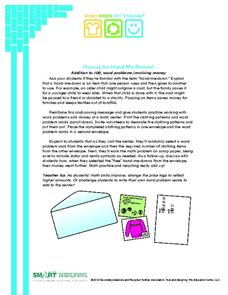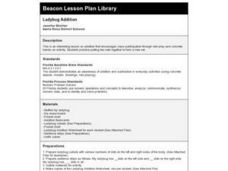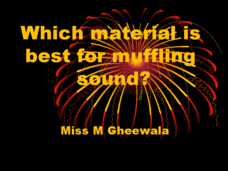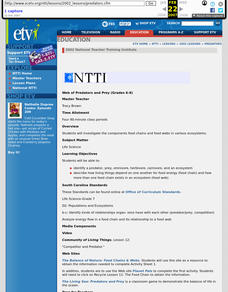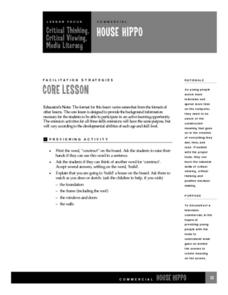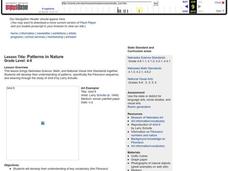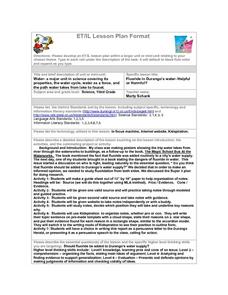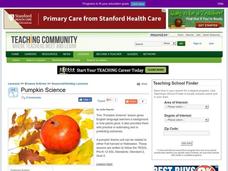Curated OER
Hooray for Hand-Me-Downs!
Youngsters learn how "hand-me-downs" can help save money while practicing math word problems with this fun learning center activity.
Resources for Educators
Math & Science Connection
Whether you're using a collection of Dr. Seuss books to teach basic math skills like counting, adding, and subtracting, or exploring the different states of matter by melting a crayon with a hairdryer, a series...
Curated OER
Ladybug Addition
Students engage in an interesting lesson on addition that encourages class participation through role-play and concrete hands-on activity. They utilize the fact that ladybugs have dots on their bodies to create a fun, hands-on lesson in...
Curated OER
Which Material is Best for Muffling Sound?
Two professors, Big-Hair and Bee-Hive, cannot do their work because the alarm clock won't stop ringing! Young scientists perform an experiment to help them wrap the clock in the best material for muffling the sound. This is a clever...
PreKinders
Parts of a Tree
Don't bark up the wrong tree with this set of cards! Seven cards present different parts of a tree, including a trunk, branches, and leaves. A great addition to your science or language arts lesson.
Curated OER
Restaurants and Institutional Examination 4
Match the vocabulary terms in column A with the definitions in column B. Write the letter of the definition in column B in the space next to the terms in column A.Write short answers or fill in the blank to the following questions and...
Curated OER
Blast It! (Learning About Copper)
Opening with background information on copper use and mining, this worksheet assesses junior geologists' reading comprehension. A map activity is available, but the map is not. There is a useful set of vocabulary matching cards and a...
Curated OER
Biotic and Abiotic Factors
In this biotic and abiotic factors worksheet, students complete 20 various types of questions related to biotic and abiotic factors. First, they write the vocabulary word that best completes the sentence. Then, students state an example...
Curated OER
Web of Predators and Prey
Middle schoolers investigate the components food chains and food webs in various ecosystems. They describe how living things depend on one another for food energy (food chain) and how more than one food chain exists in an ecosystem
Forest Foundation
Fire Investigation and Experimentation
Assess the probability of a wildfire with several lessons about fire danger ratings and risk factors. After experimenting with fuel moisture, learners explore the various elements that could contribute to a wildfire, such as wind...
Curated OER
Unit 2 Sun & Stars
Young scholars describe stellar objects using terms such as stars, planets, satellites, orbits and light. For this sun and stars unit, students research stellar objects through seven individual lessons discovering star characteristics,...
Curated OER
Cell Organelles
Students explore biology by researching living cells. In this living organism lesson, students participate in a role-playing activity in which all the students in class form one plant cell by portraying specific parts of a cell. Students...
Curated OER
House Hippo
Students predict the purpose of a presented commercial. They discuss the challenges of making the hippo seem to be in living in the kitchen. In addition, they design a setting or background to create an illusion in their own pictures.
Curated OER
The Mosquito
In this reading comprehension worksheet, students watch the video The Mosquito and write missing words into sentences about the video. Students complete 28 missing words.
Curated OER
Patterns in Nature
Students learn about artist Larry Schulte and view examples of his work. They create addition sentence for the first seven numbers of the fibonacci sequence and use unifix cubes to build that sentences. Students color and create three...
Curated OER
Fluoride in Durango's Water-Helpful or Harmful?
Third graders complete several activities in their quest to find out about the addition of fluoride to city water. First, they create a guide sheet to help organize notes. The next two steps involve taking notes through guided practice....
Curated OER
Mutation and Genetic Change
In this genetic change learning exercise, students read about how mutations can occur in germ cells and somatic cells. Students complete 1 multiple choice and 4 short answer questions.
Curated OER
Too Much Oxygen or Too Little?
In this oxygen worksheet, students analyze date about the oxygen levels in a river to determine the cause of the dying fish. This worksheet has 2 graphs, 12 short answer questions, and 2 graphic organizers.
Curated OER
Web of Predators and Prey
Students investigate the food chain by researching the Internet. In this ecosystem lesson plan, students view the video "Competitor and Predator" and read a book from the series "The Magic School Bus." Students utilize a...
Curated OER
Chemistry and the Food System
In this chemistry worksheet, students review how chemistry has helped grow and preserve different foods. This worksheet has 11 fill in the blank, 3 multiple choice, and 6 short answer questions.
Curated OER
Food Energy and Nutrients
In this food energy and nutrients worksheet, students fill in the blank and complete a chart with information about food energy and essential nutrients needed for the body. Using the Nelson text, students complete a chart about...
Curated OER
Pumpkin Science
Young scholars investigate how plants grow by analyzing pumpkins. In this agricultural lesson, students read The Biggest Pumpkin Ever by Steven Kroll, and draw pictures of a pumpkin in each of its growing stages. Young scholars measure...
Curated OER
How Atoms Work
Students analyze the way atoms function and how they combine to form molecules and various compounds. Using a software program, they create a diagram of an atom and write a summary about their functions. They complete a worksheet and...
Curated OER
How Atoms Work
Students explore the concept of atoms and how they combine to form molecules and compounds. In pairs, they read an article on how atoms work and discuss the main points. They draw atoms and write a paragraph about their elements.
